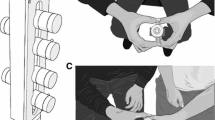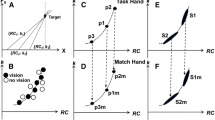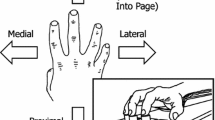Abstract
We studied static prehension of a horizontally oriented object. Specific hypotheses were explored addressing such issues as the sharing patterns of the total moment of force across the digits, presence of mechanically unnecessary digit forces, and trade-off between multi-digit synergies at the two levels of the assumed control hierarchy. Within the assumed hierarchy, at the upper level, the task is shared between the thumb and virtual finger (an imagined finger producing a wrench equal to the sum of the wrenches of individual fingers). At the lower level, action of the virtual finger is shared among the four actual fingers. The subjects held statically a horizontally oriented handle instrumented with six-component force/torque sensors with different loads and torques acting about the long axis of the handle. The thumb acted from above while the four fingers supported the weight of the object. When the external torque was zero, the thumb produced mechanically unnecessary force of about 2.8 N, which did not depend on the external load magnitude. When the external torque was not zero, tangential forces produced over 80% of the total moment of force. The normal forces by the middle and ring fingers produced consistent moments against the external torque, while the normal forces of the index and little fingers did not. Force and moment variables at both hierarchical levels were stabilized by covaried across trials adjustments of forces/moments produced by individual digits with the exception of the normal force analyzed at the lower level of the hierarchy. There was a trade-off between synergy indices computed at the two levels of the hierarchy for the three components of the total force vector, but not for the moment of force components. Overall, the results have shown that task mechanics are only one factor that defines forces produced by individual digits. Other factors, such as loading sensory receptors may lead to mechanically unnecessary forces. There seems to be no single rule (for example, ensuring similar safety margin values) that would describe sharing of the normal and tangential forces and be valid across tasks. Fingers that are traditionally viewed as less accurate (e.g., the ring finger) may perform more consistently in certain tasks. The observations of the trade-off between the synergy indices computed at two levels for the force variables but not for the moment of force variables suggest that the degree of redundancy (the number of excessive elemental variables) at the higher level is an important factor.











Similar content being viewed by others
References
Aoki T, Latash ML, Zatsiorsky VM (2007) Adjustments to local friction in multi-finger prehension. J Motor Behav 39:276–290
Arbib MA, Iberall T, Lyons D (1985) Coordinated control programs for movements of the hand. In: Goodwin AW, Darian-Smith I (eds) Hand function and the neocortex. Springer, Berlin, pp 111–129
Baud-Bovy G, Soechting JF (2001) Two virtual fingers in the control of the tripod grasp. J Neurophysiol 86:604–615
Burstedt MK, Edin BB, Johansson RS (1997) Coordination of fingertip forces during human manipulation can emerge from independent neural networks controlling each engaged digit. Exp Brain Res 117:67–79
Burstedt MK, Flanagan JR, Johansson RS (1999) Control of grasp stability in humans under different frictional conditions during multidigit manipulation. J Neurophysiol 82:2393–2405
Ducic I, Dellon AL, Bogue DP (2006) Radial sensory neurotization of the thumb and index finger for prehension after proximal median and ulnar nerve injuries. J Reconstr Microsurg 22:73–78
Feldman AG, Goussev V, Sangole A, Levin MF (2007) Threshold position control and the principle of minimal interaction in motor actions. Prog Brain Res 165:267–281
Flanagan JR, Wing AM (1993) Modulation of grasp force with load force during point-to-point arm movements. Exp Brain Res 95:131–143
Flanagan JR, Wing AM (1995) The stability of precision grasp forces during cyclic arm movements with a hand-held load. Exp Brain Res 105:455–464
Gentilucci M, Caselli L, Secchi C (2003) Finger control in the tripod grasp. Exp Brain Res 149:351–360
Gorniak S, Zatsiorsky VM, Latash ML (2007a) Hierarchies of synergies: an example of the two-hand, multi-finger tasks. Exp Brain Res 179:167–180
Gorniak S, Zatsiorsky VM, Latash ML (2007b) Emerging and disappearing synergies in a hierarchically controlled system. Exp Brain Res 183:259–270
Gorniak SL, Duarte M, Latash ML (2008) Do synergies improve accuracy? A study of speed-accuracy trade-offs during finger force production. Mot Control 12:151–172
Gorniak SL, Zatsiorsky VM, Latash ML (2009) Hierarchical control of static prehension: II. Multi-digit synergies. Exp Brain Res 194:1–15
Johansson RS, Westling G (1984) Roles of glabrous skin receptors and sensorimotor memory in automatic control of precision grip when lifting rougher or more slippery objects. Exp Brain Res 56:550–564
Kinoshita H, Backstrom L, Flanagan JR, Johansson RS (1997) Tangential torque effects on the control of grasp forces when holding objects with a precision grip. J Neurophysiol 78:1619–1630
Latash ML (2010) Motor synergies and the equilibrium-point hypothesis. Mot Control 14:294–322
Latash ML, Zatsiorsky VM (2009) Multi-finger prehension: control of a redundant motor system. Adv Exp Med Biol 629:597–618
Latash ML, Scholz JP, Schöner G (2007) Toward a new theory of motor synergies. Mot Control 11:276–308
Li ZM, Latash ML, Zatsiorsky VM (1998) Force sharing among fingers as a model of the redundancy problem. Exp Brain Res 119:276–286
McIsaac TL, Santello M, Johnston JA, Zhang W, Gordon AM (2009) Task-specific modulation of multi-digit forces to object texture. Exp Brain Res 94:79–90
Pataky TC, Latash ML, Zatsiorsky VM (2004a) Prehension synergies during non-vertical grasping. I. Experimental observations. Biol Cybern 91:148–158
Pataky TC, Latash ML, Zatsiorsky VM (2004b) Tangential load sharing among fingers during prehension. Ergonomics 47:876–889
Quaney BM, Cole KJ (2004) Distributing vertical forces between the digits during gripping and lifting: the effects of rotating the hand versus rotating the object. Exp Brain Res 155:145–155
Savescu AV, Latash ML, Zatsiorsky VM (2008) A technique to determine friction at the fingertips. J Appl Biomech 24:43–50
Schieber MH, Santello M (2004) Hand function: peripheral and central constraints on performance. J Appl Physiol 96:2293–2300
Seo NJ, Armstrong TJ, Drinkaus P (2009) A comparison of two methods of measuring static coefficient of friction at low normal forces: a pilot study. Ergonomics 52:121–135
Shim JK, Latash ML, Zatsiorsky VM (2003) Prehension synergies: Trial-to-trial variability and hierarchical organization of stable performance. Exp Brain Res 152:173–184
Shim JK, Latash ML, Zatsiorsky VM (2005a) Prehension synergies in three dimensions. J Neurophysiol 93:766–776
Shim JK, Latash ML, Zatsiorsky VM (2005b) Prehension synergies: trial-to-trial variability and principle of superposition during static prehension in three dimensions. J Neurophysiol 93:3649–3658
Sun Y, Zatsiorsky VM, Latash ML (2011) Prehension of half-full and half-empty glasses: time and history effects on multi-digit coordination. Exp Brain Res 209:571–585
Wang J, Sainburg RL (2007) The dominant and nondominant arms are specialized for stabilizing different features of task performance. Exp Brain Res 178:565–570
Zatsiorsky VM, Latash ML (2008) Multi-finger prehension: an overview. J Motor Behav 40:446–476
Zatsiorsky VM, Li ZM, Latash ML (2000) Enslaving effects in multi-finger force production. Exp Brain Res 131:187–195
Zatsiorsky VM, Gregory RW, Latash ML (2002) Force and torque production in static multi-finger prehension: biomechanics and control. Part I. Biomechanics. Biol Cybern 87:50–57
Zatsiorsky VM, Gao F, Latash ML (2003a) Prehension synergies: effects of object geometry and prescribed torques. Exp Brain Res 148:77–87
Zatsiorsky VM, Gao F, Latash ML (2003b) Finger force vectors in multi-finger prehension. J Biomech 36:1745–1749
Zhang W, Scholz JP, Zatsiorsky VM, Latash ML (2008) What do synergies do? Effects of secondary constraints on multi-digit synergies in accurate force-production tasks. J Neurophysiol 99:500–513
Acknowledgments
The study was supported in part by NIH grants AG-018751, NS-035032, and AR-048563.
Author information
Authors and Affiliations
Corresponding author
Rights and permissions
About this article
Cite this article
Wu, YH., Zatsiorsky, V.M. & Latash, M.L. Static prehension of a horizontally oriented object in three dimensions. Exp Brain Res 216, 249–261 (2012). https://doi.org/10.1007/s00221-011-2923-5
Received:
Accepted:
Published:
Issue Date:
DOI: https://doi.org/10.1007/s00221-011-2923-5




